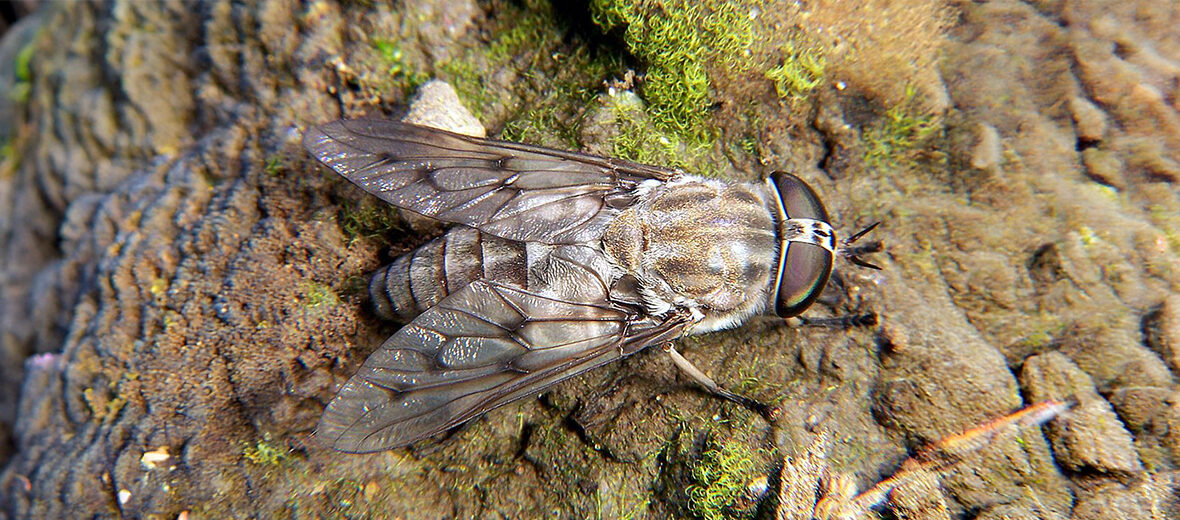
The horse fly, aka deer fly (misnomer) or gadfly, can be found all over the world, sans a few select islands and the polar regions. Female horse flies can transfer blood-borne diseases from 1 animal to another via their feeding habit. In locations where those diseases occur, they have been known to carry the equine infectious anaemia virus, some trypanosomes, anthrax among cattle and sheep, and tularemia. They can reduce growth rates in cattle and lower the milk output of cows if proper shelters aren’t available. The only horse fly listed with the IUCN is the Belkin’s dune tabanid fly, and those are classified as Vulnerable. All others are not evaluated, or are extinct.
First the Stats…
Scientific name: Tabanidae
Weight: Up to 0.00042 ounce
Length: Up to 1.25 inches
Wingspan: Up to 2.4 inches
Lifespan: Up to 60 days
Now on to the Facts!
1.) Horse flies have been mentioned in literature ever since Aeschylus in Ancient Greece mentioned them driving people to “madness” through their constant assaults.
2.) Other names these pests go by are clags, clegs, dun-flies, green flies, green-headed flies, March flies, stouts, and tabanids.
3.) Some species, like the deer flies and the Australian March flies, are known for being extremely noisy during flight, though clegs, for example, fly quietly and bite without warning.
4.) Horse flies are touted as being the fastest flying insect, with speeds of up to 90 mph recorded!
5.) Only Greenland, Hawaii, and Iceland lack these biting insects, and, as mentioned, the polar regions.
But wait, there’s more on the horse fly!
6.) They are found from sea level up to 10,800 foot elevations.
7.) These pests date back as far as the Berriasian period, 145 million years ago.
Did you know…?
Only the females bite animals and humans to obtain a blood meal.
8.) With a need for high-protein food to precipitate egg production, the diet of early tabanomorphs was likely predatory, and out of this, the bloodsucking habit may have evolved.
9.) Both males and females participate in nectar-feeding, but females of most species are anautogenous. This means that they require a blood meal before they are able to effectively reproduce.
10.) The female needs about 6 days to fully digest her blood meal and following that, she will need to find another host.
But wait, there’s still more on the horse fly!
11.) Like mosquitoes, these bloodsuckers appear to be attracted to a potential victim by its movement, surface texture, warmth, and by the carbon dioxide the victim produces.
12.) The primary targets for blood meals are large mammals such as camels, cattle, deer, and horses, but most species have no preference of hosts, as long as they meet the above requirements of movement, texture, temperature, and CO2 production.
Did you know…?
Since these parasites are attracted by the polarized reflections from water, this makes them a definite nuisance near swimming pools and lakes.
13.) Birds, lizards, and turtles, as well as recently deceased animals are also parasitized.
14.) Horse flies, unlike mosquitoes, have an irritating bite. However, since large animals and livestock are typically powerless to dislodge these flies, there is no selective advantage for the flies to evolve a less immediately painful bite.
15.) Seeing as their bite is immediately noticeable, they are often brushed away. Therefor, they must visit several hosts in order to obtain an appropriate amount of blood. This is where the potential for disease transmission comes into play.
But wait, there’s still a bit more on the horse fly!
16.) They prefer to be in sunlight, so they typically avoid shady places like barns, and are thus diurnal (active during the day) and inactive at night.
17.) The attack patterns vary based on the species. For example, clegs fly silently and like to bite humans on the wrist or bare leg; larger species of Tabanus fly low, buzz loudly, and bite ankles, legs, or backs of knees; Chrysops typically flies a bit higher, bites the back of the neck, and has a high buzzing pitch.
Did you know…?
It is believed that the striped patterns of zebras is an evolutionary trait that came about as a means to thwart these biting pests.
18.) Females lay their eggs on stones or vegetation close to or over water, in clusters of up to 1,000, mostly on emergent water plants.
19.) Eggs hatch in up to 6 days, with the emerging larvae using a special hatching spike to open the egg case.
20.) These flies and their larvae are in turn parasitized by wasps and tachinid flies. The larvae and adults are also preyed on by birds.
But wait, there’s still a tad more on the horse fly!
21.) Horse flies are known vectors for certain blood-borne bacterial, viral, protozoan, and worm diseases of mammals, like the equine infectious anaemia virus & various species of Trypanosoma, which cause diseases in animals and humans.
22.) Some species can transmit the parasitic filarial worm Loa loa between humans. They are known to transmit anthrax among cattle and sheep, and tularemia between rabbits and humans.
Did you know…?
Bites are not only painful, but typically cause a weal (raised area of skin) around the bite area. Other symptoms can include urticaria (a rash), dizziness, weakness, wheezing, and angioedema (a temporary itchy, pink, or red swelling around the eyes or lips). Some people experience an allergic reaction.
23.) Blood loss is another common problem that can occur among animals. There have been reports of up to 10 ounces of blood loss in a single day from these pests. This is enough to weaken or even kill some animals.
24.) Control of these flies is challenging. But some methods include insecticidal ear tags, Manitoba traps, pyrethroids that are sprayed on or poured on animals, and more.
25.) In Prometheus Bound, which is attributed to the Athenian tragic playwright Aeschylus, a gadfly sent by Zeus’s wife Hera pursues and causes distraught to his mistress Io, who has been transformed into a cow & is constantly watched by the hundred eyes of the herdsman Argus: “Io: Ah! Hah! Again the prick, the stab of gadfly-sting! O earth, earth, hide, the hollow shape Argus that evil thing the hundred-eyed.”
Now a Short Horse Fly Video!
Be sure to share & comment below! Also, check out the Critter Science YouTube channel. Videos added regularly!
Want to suggest a critter for me to write about? Let me know here.
Some source material acquired from: Wikipedia & IUCN
Photo credit: Bruce Marlin




